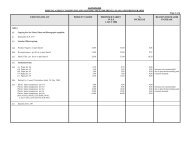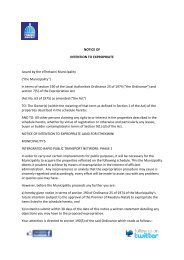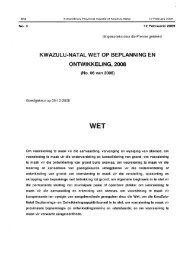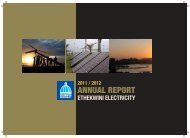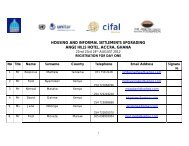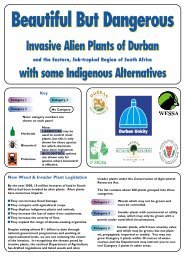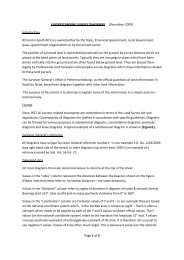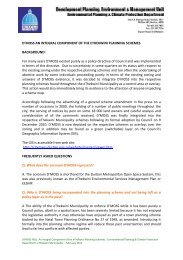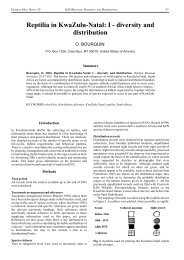Mullin, S. K., Taylor, P. J. & Pillay, N. 2004. Skull size and ... - Durban
Mullin, S. K., Taylor, P. J. & Pillay, N. 2004. Skull size and ... - Durban
Mullin, S. K., Taylor, P. J. & Pillay, N. 2004. Skull size and ... - Durban
Create successful ePaper yourself
Turn your PDF publications into a flip-book with our unique Google optimized e-Paper software.
MULLIN_08 13/08/04 12:45 Page 19<br />
from the Limpopo <strong>and</strong> Mpumalanga Provinces were<br />
generally characterised as having an intermediate<br />
<strong>size</strong>. Dasymys foxi was larger than D. rufulus in all<br />
of the characters except four: HB/TL, NAS,<br />
GML <strong>and</strong> GHS. Within the subspecies D.<br />
incomtus, specimens from the KwaZulu-Natal<br />
were larger than D. i. incomtus from the Limpopo<br />
<strong>and</strong> Mpumalanga Provinces in all of the characters<br />
excepting HF, UTR, FMW <strong>and</strong> UMW.<br />
Fig. 7 provides a CA phenogram based on the<br />
11 distinct groups. The correlation coefficient was<br />
0.951 indicating a very good fit of the data.<br />
Cluster 1 comprised 7 of the 11 distinct morphological<br />
forms, with the exception of the montane<br />
forms, D. i. longipilosus <strong>and</strong> D. montanus, <strong>and</strong> the<br />
two largest forms, D. nudipes <strong>and</strong> Okavango<br />
Delta Dasymys. Within Cluster 1, D. i. capensis<br />
<strong>and</strong> KwaZulu-Natal D. i. incomtus, South Africa<br />
formed a distinct grouping (Subcluster A) from<br />
P R O O F<br />
Subcluster B, which had three distinct groups: 1-D.<br />
foxi <strong>and</strong> D. i. incomtus from the Limpopo <strong>and</strong><br />
Mpumalanga Provinces; 2-material from East<br />
Africa <strong>and</strong> D. rufulus; <strong>and</strong> 3-D. i. griseifrons.<br />
Cluster 2 comprised Cluster 1 as well as the<br />
Okavango Delta Dasymys, D. montanus <strong>and</strong><br />
D. nudipes, while Cluster 3 separated D. i. longipilosus<br />
from the other Dasymys specimens.<br />
DISCUSSION<br />
Our dataset was somewhat cumbersome to analyze<br />
given the large geographic area considered as well<br />
as the lack of clear-cut boundaries between groups.<br />
African Dasymys systematics<br />
D. i. capensis 0.28 7.94 (7) D. nudipes 0.35 12.28 (8)<br />
D. nudipes 0.24 8.62 (10) D. i. capensis 0.31 12.36 (7)<br />
Dorsal CS D. montanus 35.39 607.65 (3) Ventral CS D. montanus 23.43 618.64 (3)<br />
F-value = 23.00 D. rufulus 29.21 644.07 (172) F-value = 26.26 D. rufulus 29.24 651.67 (146)<br />
East Africa 31.38 664.94 (94) East Africa 30.23 678.17 (96)<br />
D. i. griseifrons 33.14 670.21 (4) D. i. griseifrons 37.31 682.75 (4)<br />
D. incomtus L/MP 32.60 673.97 (43) D. incomtus L/MP 37.66 686.91 (39)<br />
D. foxi 36.27 679.17 (13) D. foxi 33.7 695.61 (11)<br />
Okavango Delta 33.68 690.91 (30) Okavango Delta 32.67 702.98 (21)<br />
D. nudipes 45.22 706.51 (20) D. incomtus KZN 34.14 719.37 (22)<br />
D. incomtus KZN 31.18 710.63 (24) D. i. capensis 38.07 720.52 (6)<br />
D. i. capensis 30.52 715.85 (5) D. nudipes 26.77 755.99 (9)<br />
MAMMALIA • 2004 • 68 (2)<br />
Although the morphological evidence presented<br />
here is helpful in providing insight into the interspecific<br />
relationships within Dasymys, it is apparent<br />
that genetic data are needed to resolve certain<br />
aspects of its phylogeny. Additional material, particularly<br />
from the DRC, Sudan, Malawi,<br />
Mozambique <strong>and</strong> Tanzania is also required in<br />
future studies as these areas appear to be key in<br />
discerning distributional limits of species or<br />
species complexes in Dasymys as well as in clarifying<br />
the taxonomic position of the genus within<br />
these areas. Five species of Dasymys are currently<br />
recognised: D. foxi, D. montanus, D. nudipes,<br />
D. rufulus <strong>and</strong> D. incomtus (Musser & Carleton<br />
1993). The results from this study confirm the<br />
existence of all of these species but do not agree<br />
with the current distribution limits for D. rufulus<br />
<strong>and</strong> D. incomtus. The data also suggest that six<br />
additional morphological species may exist. Two<br />
of them would not correspond to previously<br />
described forms <strong>and</strong> four would result from the<br />
elevation of already recognised subspecies, bringing<br />
the proposed total number of Dasymys species<br />
to 11.<br />
Karyotypic evidence supports a polytypic Dasymys<br />
genus, with chromosomal differences indicating<br />
separate species (Maddalena et al. 1989; Granjon<br />
et al. 1992; Volobouev et al. 2000). The morphometric<br />
<strong>and</strong> geometric results presented here confirm<br />
the chromosomal separation noted below in that<br />
west African material has a similar skull structure<br />
to the two karyotypic races of D. i. incomtus in<br />
South Africa <strong>and</strong> that material from Ethiopia,<br />
west Africa <strong>and</strong> east Africa all have different<br />
19


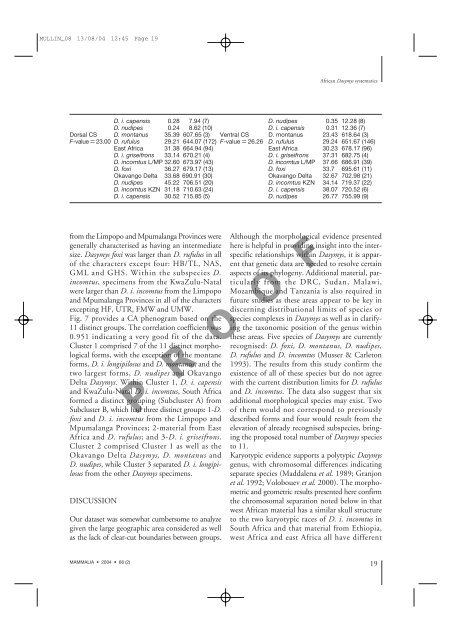
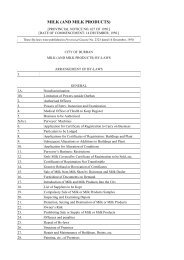
![INK Environmental Sustainability Booklet [19 MB] - Durban](https://img.yumpu.com/22025104/1/190x136/ink-environmental-sustainability-booklet-19-mb-durban.jpg?quality=85)

